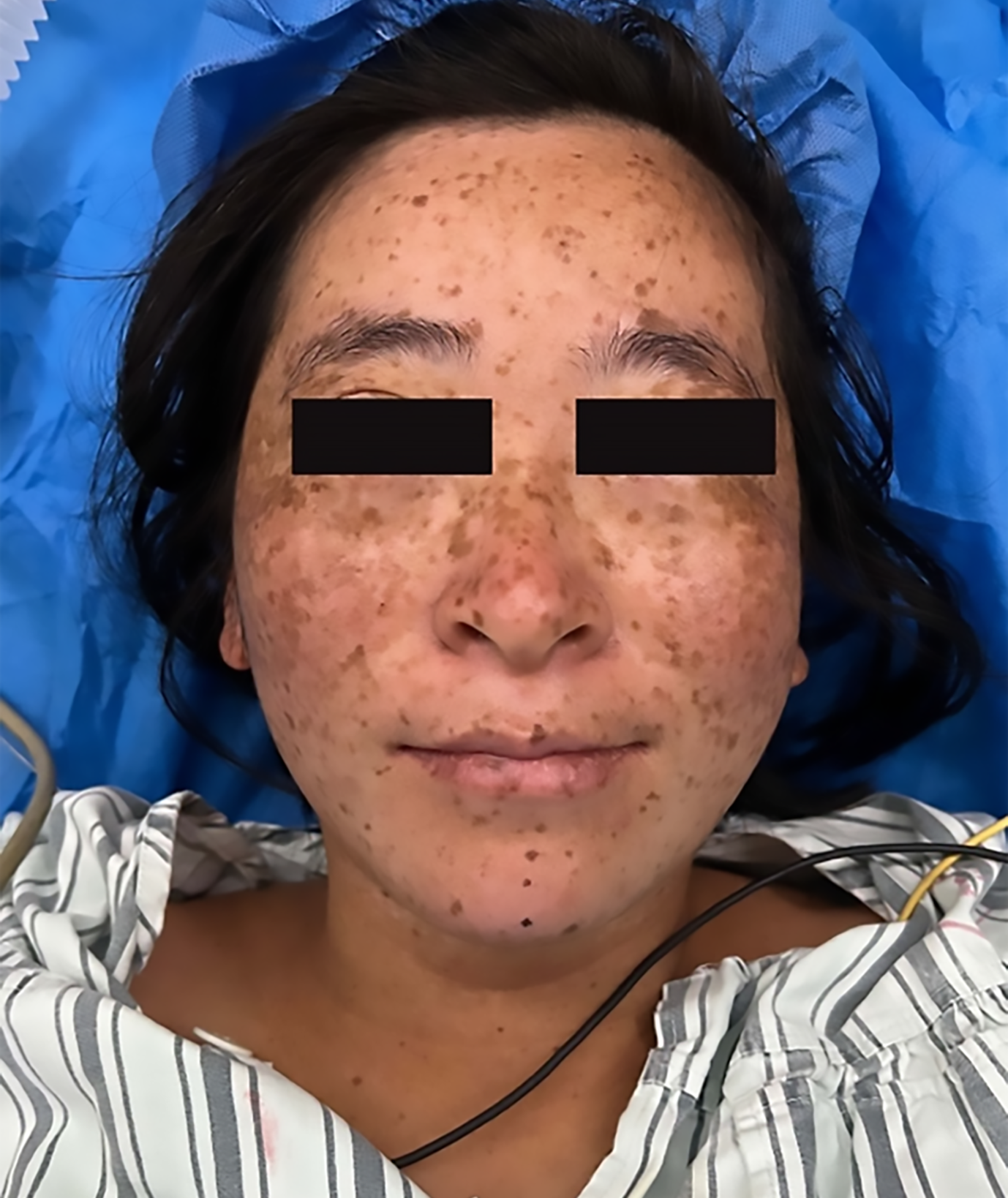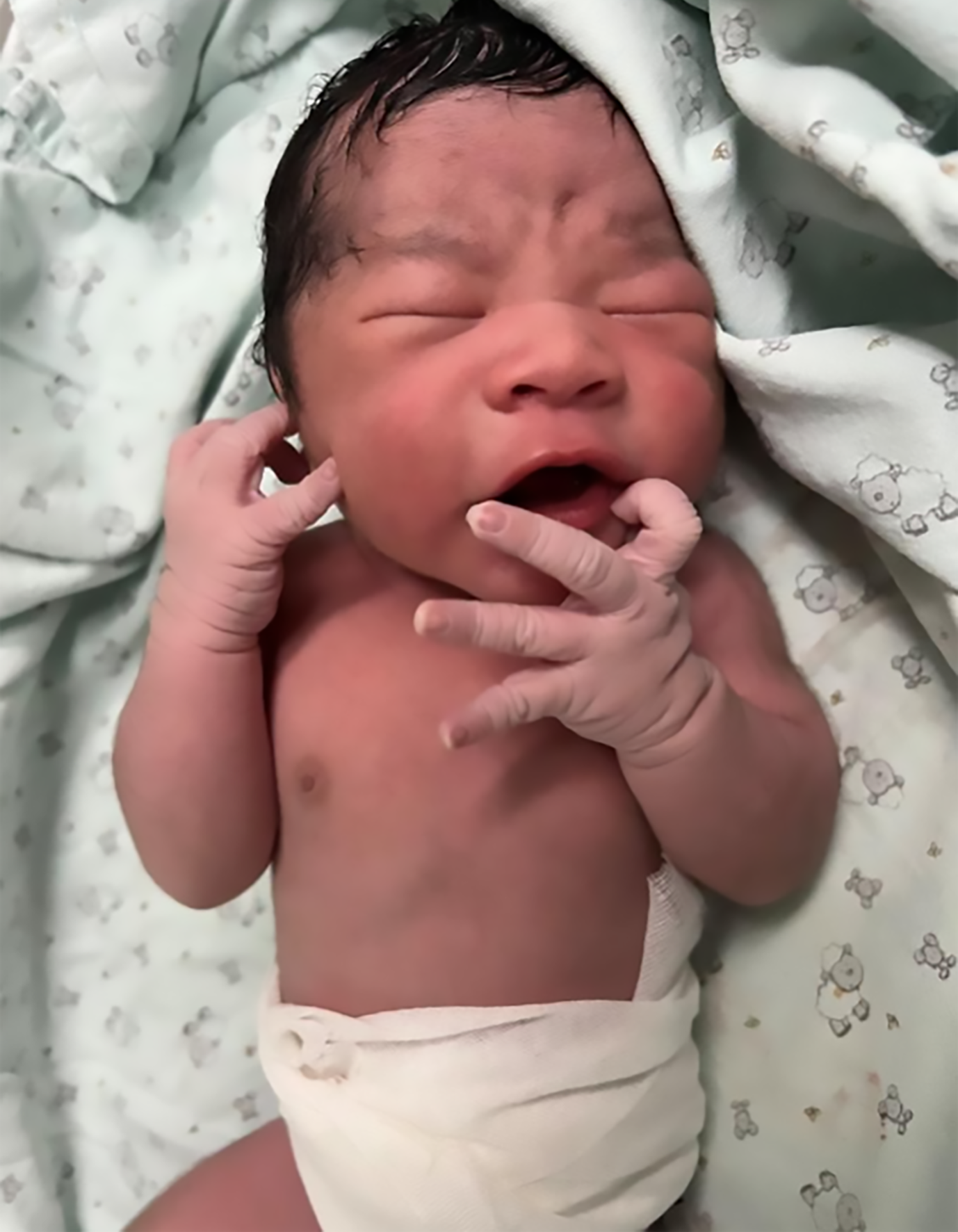Published online Nov 6, 2025. doi: 10.12998/wjcc.v13.i31.110620
Revised: July 10, 2025
Accepted: September 9, 2025
Published online: November 6, 2025
Processing time: 141 Days and 20.6 Hours
Dyschromatosis universalis hereditaria (DUH) is a rare type of autosomal dominant inheritance disease. It has varying gene mutation sites among different ethnicities. SASH1 and ABCB6 have been identified as the causative genes of this disorder.
A 30-year-old woman presented with irregular black pigmentation spots to our department. Upon examination, the pigmentations were found to be especially dense on the extremities and the face. She had no family history of inbreeding, nor any previous chemical exposure. Genetic testing confirmed that the disease occu
Using assisted reproductive technology/preimplantation genetic testing for monogenic disorders is an option for DUH patients to reduce the risk of trans
Core Tip: This case report presents a woman with dyschromatosis universalis hereditaria (DUH) carrying a novel SASH1 variant. By applying preimplantation genetic testing for monogenic disorders (PGT-M) with assisted reproductive technology, an unaffected embryo was selected, leading to the birth of a healthy child. The report highlights PGT-M as a promising approach to reduce DUH transmission, emphasizing the role of genetic counseling and long-term follow-up.
- Citation: Wang XL, Zou T, Wu YC, Weng YY, Yao Q, Sun WW. Preventing transmission of dyschromatosis universalis hereditaria through preimplantation genetic testing: A case report. World J Clin Cases 2025; 13(31): 110620
- URL: https://www.wjgnet.com/2307-8960/full/v13/i31/110620.htm
- DOI: https://dx.doi.org/10.12998/wjcc.v13.i31.110620
Dyschromatosis universalis hereditaria (DUH) is a rare type of autosomal dominant inheritance disease. It has varying gene mutation sites among different ethnicities. SASH1 and ABCB6 have been identified as the causative genes of this disorder. In this paper, we describe how assisted reproductive technology (ART) combined with preimplantation genetic testing for monogenic disorders (PGT-M) can be used to assist pregnant women in preventing their descendants from experiencing the same disease or the symptoms.
Vaginal discharge for 8 hours.
The patient had regular menstruation. One 5-day frozen embryo was transplanted in our hospital on July 26, 2021 and survived. More than 10 days after transplantation, human chorionic gonadotropin positive blood test indicated pregnancy, and ultrasound examination indicated intrauterine pregnancy. During early pregnancy, there was no history of vaginal bleeding, fluid flow, use of non-toxic substances or drugs, and radiation exposure. The fetal nuchal translucency measurement was normal. At 13+6 weeks of pregnancy, the patient underwent regular prenatal examinations in our hospital. At about four months of pregnancy, she could feel the fetal movements. Due to the previous diagnosis of DUH in the dermatology department, she went to the eugenics and genetics department of our hospital, and was recommended to perform amniocentesis, and the result was normal. During pregnancy, her thyroid function, liver and kidney function, glucose tolerance test, fetal heart ultrasound, and fetal system ultrasound were normal. In the second and third trimesters of pregnancy, the patient had no chest tightness, dizziness, pruritus, overeating, polydipsia, or polyuria, and no edema of both limbs. And when she was 40+2 weeks pregnant, after no obvious reason for vaginal discharge for 8 hours, she was admitted to the emergency medicine department of the hospital. The patient had clear liquid saturation of her underwear, without vaginal bleeding, abdominal pain, or obvious uterine contraction. During pregnancy, she had a good appetite, her feces and urine were normal, and she had a 15 kg weight gain during pregnancy.
The patient had an artificial abortion in 2020, and had been diagnosed with DUH in the dermatology department. She had no history of hepatitis, tuberculosis, or other infectious diseases. She had been vaccinated according to regulations, and she had no history of allergy, trauma, or blood transfusion.
The patient was an employee and lived in her native country for a long time. She had never been to pastoral areas or epidemic areas, and she had no history of drug use, smoking, or drinking. Her parents are healthy and have no family history or genetic history.
The obstetric examination revealed a uterine height of 35 cm and an abdominal circumference of 102 cm. The fetus was in cephalic position with a heart rate of 133 times/minute. The pelvic outlet measurement showed an intertuberous diameter of 8 cm. No uterine contractions were detected. On internal examination, the first exposed part was at station S-3; the cervix was mid-position, medium consistency, uneffaced, and closed; no abnormalities were detected in the internal pelvis; and no obvious fluid leakage was observed in the vagina.
Laboratory examinations were normal.
Imaging examinations were normal.
Premature rupture of membranes; two loops of nuchal cord; pregnancy achieved via ART; pregnancy complicated by DUH, G2P0+1, 40+2 weeks of intrauterine pregnancy with single live fetus in cephalic position.
The patient underwent ART, including intracytoplasmic sperm injection, followed by PGT-M using array comparative genomic hybridization and whole exome sequencing. The identified pathogenic SASH1 c.1574C>G variant was used to design the genetic screening. One embryo without the variant was selected and transferred, aiming to reduce the risk of transmitting the disorder to the offspring.
At a follow-up appointment three years later, the phenotype of the same disease as that found in the patient was not found in the baby.
DUH is a rare hereditary pigmentary disorder that is generally autosomal dominant[1]. It is characterized by asymptomatic hypopigmentation and hyperpigmentation[2,3] (Figures 1 and 2). Although the reticulated macules vary in size and location, they always appear in early childhood or infancy[2]. In this paper, we report the case of a pregnant woman affected by the SASH1 gene c.1574C>G variant. This mutation was not found in the National Center for Biotechnology Information Database of Short Genetic Variation, the Online Mendelian Inheritance in Man, ClinVar, or 1000 Genomes Project databases[4]. Following the use of ART combined with PGT-M, the patient gave birth to a healthy baby with no DUH phenotype (Figure 3). This case highlights the potential role of PGT-M as a preventive option for families affected by DUH. While ART/PGT-M does not modify or “inhibit” genes, it enables the identification and transfer of embryos without known pathogenic variants, thereby reducing the risk of transmission of monogenic disorders like DUH. Further studies and long-term follow-up are necessary to better evaluate its efficacy, limitations, and ethical considerations in rare pigmentary diseases[5].
PGT-M combined with ART may offer a feasible reproductive option for individuals with DUH who wish to reduce the risk of transmitting the disorder to their offspring. Genetic counseling, careful variant interpretation, and long-term follow-up are essential to ensure accurate decision-making and clinical outcomes.
We thank the patient for granting permission to publish this case report.
| 1. | Xing QH, Wang MT, Chen XD, Feng GY, Ji HY, Yang JD, Gao JJ, Qin W, Qian XQ, Wu SN, He L. A gene locus responsible for dyschromatosis symmetrica hereditaria (DSH) maps to chromosome 6q24.2-q25.2. Am J Hum Genet. 2003;73:377-382. [RCA] [PubMed] [DOI] [Full Text] [Cited by in Crossref: 50] [Cited by in RCA: 48] [Article Influence: 2.2] [Reference Citation Analysis (0)] |
| 2. | Stuhrmann M, Hennies HC, Bukhari IA, Brakensiek K, Nürnberg G, Becker C, Huebener J, Miranda MC, Frye-Boukhriss H, Knothe S, Schmidtke J, El-Harith EH. Dyschromatosis universalis hereditaria: evidence for autosomal recessive inheritance and identification of a new locus on chromosome 12q21-q23. Clin Genet. 2008;73:566-572. [RCA] [PubMed] [DOI] [Full Text] [Cited by in Crossref: 39] [Cited by in RCA: 34] [Article Influence: 2.0] [Reference Citation Analysis (0)] |
| 3. | Dereure O. [Hereditary pigmentary disorders: light from the East]. Ann Dermatol Venereol. 2014;141:77-78. [RCA] [PubMed] [DOI] [Full Text] [Cited by in RCA: 1] [Reference Citation Analysis (0)] |
| 4. | Wu N, Tang L, Li X, Dai Y, Zheng X, Gao M, Wang P. Identification of a Novel Mutation in SASH1 Gene in a Chinese Family With Dyschromatosis Universalis Hereditaria and Genotype-Phenotype Correlation Analysis. Front Genet. 2020;11:841. [RCA] [PubMed] [DOI] [Full Text] [Full Text (PDF)] [Cited by in Crossref: 2] [Cited by in RCA: 12] [Article Influence: 2.4] [Reference Citation Analysis (0)] |
| 5. | Nogita T, Mitsuhashi Y, Takeo C, Tsuboi R. Removal of facial and labial lentigines in dyschromatosis universalis hereditaria with a Q-switched alexandrite laser. J Am Acad Dermatol. 2011;65:e61-e63. [RCA] [PubMed] [DOI] [Full Text] [Cited by in Crossref: 11] [Cited by in RCA: 8] [Article Influence: 0.6] [Reference Citation Analysis (0)] |















